Starring the explosive talents of Bruce Willis, Academy Awardwinners Ben Affleck and Billy Bob Thornton, Liv Tyler, Steve Buscemi, and Will Patton, ARMAGEDDON is a meteor storm of action-adventure moviemaking that has you on the edge of your seat forgetting to breathe! When NASA’s executive director, Dan Truman (Thornton), realizes the Earth has 18 days before it’s obliterated by a meteor the size of Texas, he has only one option - land a ragtag team of roughneck oil drillers on the asteroid and drop a nuclear warhead into its core. Spectacular special effects, laugh-out-loud humor, great characters, riveting storytelling, and heartfelt emotion make ARMAGEDDON an exhilarating thrill ride you’ll want to experience like there’s no tomorrow.
ARMAGEDDON is under exclusive license from Touchstone Home Video TM © 2021 by Touchstone Home Video. All Rights Reserved. © 2021 The Criterion Collection. All Rights Reserved. Cat. no. CC1548L. ISBN 1-55940-895-2.
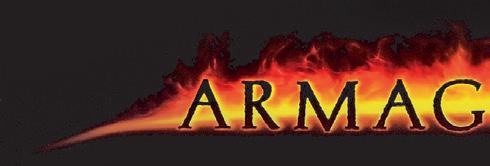
SPECIAL FEATURES
• Director’s Cut with Transfer Supervised by Director Michael Bay
• Audio commentary by producer Jerry Bruckheimer, director Michael Bay, actors Bruce Willis and Ben Affleck
• Audio commentary by Cinematographer John Schwartzman, NASA consultant Dr. Joe Allen and asteroid consultant Ivan Bekey
• Michael Bay’s gag reel
• Deleted Scenes compiled by Michael Bay
• Storyboards and production design drawings
• Analysis of the special effects by visual effects supervisors Richard Hoover, Pat McClung and Hoyt Yeatman
• Production designer Michael White on the look of Armaggedon

• “I don’t want to miss a thing” music video by Areosmith
• Interviews with Aerosmith
• Teaser trailer, Theatrical trailer and TV spots

Audio: English Dolby Digital 5.1 Surround /
Audio Commentary Dolby Digital Subtitles: English Main title: 1080p Supplementary material: 480p Laserdisc source
Warning: unauthorized public performance, broadcasting, or copying is a violation of applicable laws. Printed in the USA. First printing 2021.
1998

Design and Layout - pineapples101@gmail.com
The Criterion Collection is dedicated to gathering the greatest films from around the world and publishing them in editions of the highest technical quality, with supplemental features that enhance the appreciation of the art of film. Visit us at Criterion.com
1998 153 MINUTES COLOR 5.1 SURROUND 2.35:1 ASPECT RATIO BLU-RAY EDITION
The Criterion Collection, a continuing series of important classic and contemporary films, presents
LD 384
The Criterion Collection, a continuing series of important classic and contemporary films, presents
Starring the explosive talents of Bruce Willis, Academy Awardwinners Ben Affleck and Billy Bob Thornton, Liv Tyler, Steve Buscemi, and Will Patton, ARMAGEDDON is a meteor storm of action-adventure moviemaking that has you on the edge of your seat forgetting to breathe! When NASA’s executive director, Dan Truman (Thornton), realizes the Earth has 18 days before it’s obliterated by a meteor the size of Texas, he has only one option - land a ragtag team of roughneck oil drillers on the asteroid and drop a nuclear warhead into its core. Spectacular special effects, laugh-out-loud humor, great characters, riveting storytelling, and heartfelt emotion make ARMAGEDDON an exhilarating thrill ride you’ll want to experience like there’s no tomorrow.
SPECIAL FEATURES
• Director’s Cut with Transfer Supervised by Director Michael Bay
• Audio commentary by producer Jerry Bruckheimer, director Michael Bay, actors Bruce Willis and Ben Affleck
• Audio commentary by Cinematographer John Schwartzman, NASA consultant Dr. Joe Allen and asteroid consultant Ivan Bekey
• Michael Bay’s gag reel
• Deleted Scenes compiled by Michael Bay
• Storyboards and production design drawings
• Analysis of the special effects by visual effects supervisors Richard Hoover, Pat McClung and Hoyt Yeatman
• Production designer Michael White on the look of Armaggedon

• “I don’t want to miss a thing” music video by Areosmith
• Interviews with Aerosmith
• Teaser trailer, Theatrical trailer and TV spots

Audio: English Dolby Digital 5.1 Surround /
Audio Commentary Dolby Digital
Subtitles: English Main title: 1080p Supplementary material: 480p Laserdisc source

ARMAGEDDON is under exclusive license from Touchstone Home Video TM © 2021 by Touchstone Home Video. All Rights Reserved. © 2021 The Criterion Collection. All Rights Reserved. Cat. no. CC1548L. ISBN 1-55940-895-2. Warning: unauthorized public performance, broadcasting, or copying is a violation of applicable laws. Printed in the USA. First printing 2021.

Design and Layout - pineapples101@gmail.com
The Criterion Collection is dedicated to gathering the greatest films from around the world and publishing them in editions of the highest technical quality, with supplemental features that enhance the appreciation of the art of film. Visit us at Criterion.com
1998
1998 153
COLOR 5.1
2.35:1
BLU-RAY
LD
MINUTES
SURROUND
ASPECT RATIO
EDITION
384
The Criterion Collection, a continuing series of important classic and contemporary films, presents
Starring the explosive talents of Bruce Willis, Academy Awardwinners Ben Affleck and Billy Bob Thornton, Liv Tyler, Steve Buscemi, and Will Patton, ARMAGEDDON is a meteor storm of action-adventure moviemaking that has you on the edge of your seat forgetting to breathe! When NASA’s executive director, Dan Truman (Thornton), realizes the Earth has 18 days before it’s obliterated by a meteor the size of Texas, he has only one option - land a ragtag team of roughneck oil drillers on the asteroid and drop a nuclear warhead into its core. Spectacular special effects, laugh-out-loud humor, great characters, riveting storytelling, and heartfelt emotion make ARMAGEDDON an exhilarating thrill ride you’ll want to experience like there’s no tomorrow.
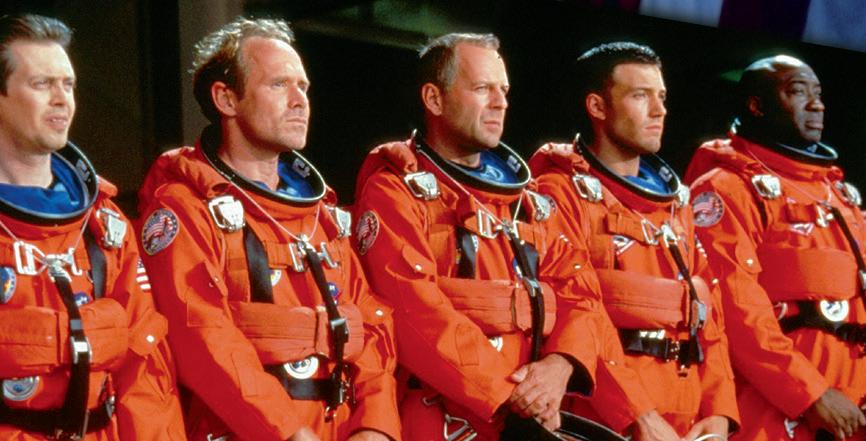
SPECIAL FEATURES
• Director’s Cut with Transfer Supervised by Director Michael Bay
• Audio commentary by producer Jerry Bruckheimer, director Michael Bay, actors Bruce Willis and Ben Affleck
• Audio commentary by Cinematographer John Schwartzman, NASA consultant Dr. Joe Allen and asteroid consultant Ivan Bekey
• Michael Bay’s gag reel
• Deleted Scenes compiled by Michael Bay
• Storyboards and production design drawings
• Analysis of the special effects by visual effects supervisors Richard Hoover, Pat McClung and Hoyt Yeatman
• Production designer Michael White on the look of Armaggedon
• “I don’t want to miss a thing” music video by Areosmith
• Interviews with Aerosmith
• Teaser trailer, Theatrical trailer and TV spots


Audio: English Dolby Digital 5.1 Surround /
Audio Commentary Dolby Digital

Subtitles: English
Main title: 480p Supplementary material: 480p Laserdisc source
The Criterion Collection is dedicated to gathering the greatest films from around the world and publishing them in editions of the highest technical quality, with supplemental features that enhance the appreciation of the art of film. Visit us at Criterion.com
Design and Layout - pineapples101@gmail.com
1998
LD
384
Warning:
1998 153 MINUTES COLOR 5.1 SURROUND 2.35:1 ASPECT RATIO DVD EDITION
ARMAGEDDON is under exclusive license from Touchstone Home Video TM © 2021 by Touchstone Home Video. All Rights Reserved. © 2021 The Criterion Collection. All Rights Reserved. Cat. no. CC1548L. ISBN 1-55940-895-2.
unauthorized public performance, broadcasting, or copying is a violation of applicable laws. Printed in the USA. First printing 2021.
PRODUCTION CREDITS
Co-producer / menu design Sean Wright-Anderson

Executive producer Peter Becker
Technical director Lee Kline
Production managers Catherine Gray, Grace Kim editorial coordinator Shannon Attaway
Audio coordinator / mixer Michael W. Wiese
Commentary
Audio

Charity Lomax / Westlake Audio, L.A. Butch Jones / Back Pocket Studios, NYC Michael W. Wiese
Telecine colorist Skip Kimball / Modern Videofilm, L.A. Package design Basie Grocholski
Production assistant Peter Hahn
Mastering Digital Video Compression Corp, L.A. Cinram / P.O.P. DVD centre, L.A.
Quality control Maria Palazzola, Will Salas
This
SPECIAL THANKS
THANKS ALSO TO
Producer Karen Stetler
editors Rex Arthur, Fletcher Chenn, and Michael W. Wiese
Assistant audio editor Heather Shaw
commentary recordists Julien Cook / Mark Graue Recording Services, L.A. Dave Berger / Pyramid National Pressport, Washington, D.C.
disc would not have been possible without the generous support of Michael Bay.
Ben Affleck, Dr. Joe Allen, Ivan Bekey, Jerry Bruckheimer, John Schwartzman, and Bruce Willis
Richard Hoover, Mary Reardon, and Hoyt Yeatman / Dream Quest Images; Bill Ackerman; Roger Barton; Jeanine Basinger, Jamie Bush; Robbie Consing; Stephen Eads; Morgan Holly; Pat McClung; Jonathan Turell; Louise Weber; Michael White; Roger White / Studio Referral Service; and especially, Brad Sisk
Despite what you may have heard, Armageddon is a work of art by a cutting-edge artist who is a master of movement, light, color, and shape—and also of chaos, razzledazzle, and explosion. (It was no surprise to me to learn that as a thirteen-year-old, director Michael Bay blew up his toy train set with firecrackers so he could photograph the result with his mom’s 8mm camera.) If he weren’t working in Hollywood, Bay would be the darling bad boy of the intelligentsia. As it is, he sometimes falls under suspicion for having been nominated for multiple MTV Awards, and for having won every accolade available to directors of commercials, including the Clio and the prestigious Director’s Guild of America “Commercial Director of the Year” title. Armageddon is only his third movie, but it came under fire from some critics who had praised his second, The Rock, and for its same characteristics: fast cutting, impressive special effects, and a minimum of exposition.
The first time I saw Michael Bay, he was a polite eighteen-year-old who stopped by my office at Wesleyan University to tell me he wanted to major in Film Studies. He also asked me if I would like to see his still photographs. As a teacher, I believe there is only one answer to that question: “Of course.” (It’s my job.) Over the years, I’ve seen a great deal of material from freshmen—short stories, novels, plays, ceramics, paintings, sculptures, prints, fashion designs, videos, computer art, movies in 8mm and 16mm, even recipe collections—but I have yet to see anything like Bay’s high school photos. They were astonishing—revealing an amazing eye for composition, an instinct for capturing movement, and an inherent understanding of implied narrative. Later, I saw this same ability in film classes. In history/theory, he listened intently, but said little, speaking mostly to ask keen questions or to deal with what he felt was nonsense from his peers. But in film production classes, he was the Road Runner, taking off on his own, needing little guidance. His senior film, Benjamin’s Birthday, won Wesleyan’s Frank Capra Prize for Best Film, and it was definitely what we now know as a “Michael Bay Film.” It was funny. It was fast. And it featured a very ritzy yellow Porsche. It told its story clearly, but in a highly nonverbal manner. Bay was ahead of his age group, but he was also ahead of his time. He still is.
It is true that Armageddon, a perfect example of Bay’s work, illustrates his “takeno-prisoners” form of storytelling, in which he trusts an audience to figure things out. (One of its strengths is its minimum of dreadful exposition that over-explains the inevitable pseudoscience.) Yes, it gives audiences a lot to absorb. Yes, it cuts quickly from place to place, person to person, event to event. But it is never confusing, never boring, and never less than a brilliant mixture of what movies are supposed to do: tell a good story, depict characters through active events, invoke an emotional response, and entertain simply and directly, without pretense.
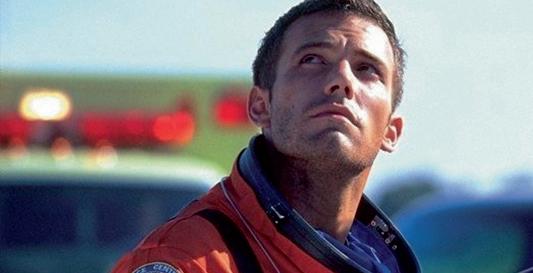


Armageddon is not for the faint-hearted, the slow-witted, or the dim-eyed. (Those who claim that it was hard to tell where characters were in relation to each other in the space should take another look.) Consider how the film explains what Harry Stamper’s (Bruce Willis) vacationing crew is doing when he sends out the word he needs them. In little more than one minute of screen time, five key characters are identified, established in a specific environment, shown relating to others, given distinct personalities, and defined in ways that indicate how they will behave on the later mission. (If that’s not screenwriting, what is?)


At its core, Armageddon is a genre picture, and like all genre pictures that arrive late in the cycle, it has been subjected to misinterpretation. Although it qualifies as a science fiction/ disaster movie, I see it as an epic form of the old Warner Brothers movies about working-class men who have to step up and rescue a situation through their courage, true grit, and knowledge of machines— productions such as Raoul Walsh’s (1941) and Alfred E. Green’s Flowing Gold (1940). The “science fiction” or “disaster movie” elements of Armageddon into the epic form—a form that exists to make movie stories we already know grander, larger, and more “real” in historic setting. (A failed epic settles for the definition put forth in Nicholas Ray’s 1950 film In a Lonely Place: “. . . a picture that’s real long and has lots and lots going on.”) Armageddon is grand, large, and set at NASA, but, the story of Stamper, his daughter, and his hard-living, oil-drilling buddies is the kind of movie that has previously been smaller and tighter. This film makes these ordinary men noble, lifting their efforts up into an epic event. Here, working men are not only saving the overeducated scientists and politicians who can’t do anything (and who probably went to Yale and Harvard), but, incidentally, the entire population of the planet.
By Jeanine Basinger JUNE 21, 1999
Jeanine Basinger is the Corwin-Fuller Professor of Film Studies, the founder and curator of the Wesleyan Cinema Archives, and the founding chair of the Film Studies Department at Wesleyan University. She is the author of eleven books on film, as well as numerous articles and book reviews, and a trustee of both the National Board of Review and the American Film Institute.

PRODUCTION CREDITS

Producer
Co-producer / menu design Sean Wright-Anderson

Executive
Production
Audio coordinator / mixer Michael W. Wiese
Commentary
Assistant
Audio
Charity
Telecine colorist Skip Kimball / Modern Videofilm, L.A. Package design Basie Grocholski
Production assistant Peter Hahn
Mastering Digital Video Compression Corp, L.A. Cinram / P.O.P. DVD centre, L.A.
Quality control Maria Palazzola, Will Salas
This
SPECIAL THANKS
THANKS ALSO
Karen Stetler
producer Peter Becker
Technical director Lee Kline
managers Catherine Gray, Grace Kim editorial coordinator Shannon Attaway
editors Rex Arthur, Fletcher Chenn, and Michael W. Wiese
audio editor Heather Shaw
commentary recordists Julien Cook / Mark Graue Recording Services, L.A.
Dave Berger / Pyramid National Pressport, Washington, D.C.
Lomax / Westlake Audio, L.A. Butch Jones / Back Pocket Studios, NYC Michael W. Wiese
disc would not have been possible without the generous support of Michael Bay.
Ben Affleck, Dr. Joe Allen, Ivan Bekey, Jerry Bruckheimer, John Schwartzman, and Bruce Willis
TO
Richard Hoover, Mary Reardon, and Hoyt Yeatman / Dream Quest Images; Bill Ackerman; Roger Barton; Jeanine Basinger, Jamie Bush; Robbie Consing; Stephen Eads; Morgan Holly; Pat McClung; Jonathan Turell; Louise Weber; Michael White; Roger White / Studio Referral Service; and especially, Brad Sisk
Despite what you may have heard, Armageddon is a work of art by a cutting-edge artist who is a master of movement, light, color, and shape—and also of chaos, razzle-dazzle, and explosion. (It was no surprise to me to learn that as a thirteen-year-old, director Michael Bay blew up his toy train set with firecrackers so he could photograph the result with his mom’s 8mm camera.) If he weren’t working in Hollywood, Bay would be the darling bad boy of the intelligentsia. As it is, he sometimes falls under suspicion for having been nominated for multiple MTV Awards, and for having won every accolade available to directors of commercials, including the Clio and the prestigious Director’s Guild of America “Commercial Director of the Year” title. Armageddon is only his third movie, but it came under fire from some critics who had praised his second, The Rock, and for its same characteristics: fast cutting, impressive special effects, and a minimum of exposition.
The first time I saw Michael Bay, he was a polite eighteen-year-old who stopped by my office at Wesleyan University to tell me he wanted to major in Film Studies. He also asked me if I would like to see his still photographs. As a teacher, I believe there is only one answer to that question: “Of course.” (It’s my job.) Over the years, I’ve seen a great deal of material from freshmen—short stories, novels, plays, ceramics, paintings, sculptures, prints, fashion designs, videos, computer art, movies in 8mm and 16mm, even recipe collections—but I have yet to see anything like Bay’s high school photos. They were astonishing—revealing an amazing eye for composition, an instinct for capturing movement, and an inherent understanding of implied narrative. Later, I saw this same ability in film classes. In history/theory, he listened intently, but said little, speaking mostly to ask keen questions or to deal with what he felt was nonsense from his peers. But in film production classes, he was the Road Runner, taking off on his own, needing little guidance. His senior film, Benjamin’s Birthday, won Wesleyan’s Frank Capra Prize for Best Film, and it was definitely what we now know as a “Michael Bay Film.” It was funny. It was fast. And it featured a very ritzy yellow Porsche. It told its story clearly, but in a highly nonverbal manner. Bay was ahead of his age group, but he was also ahead of his time. He still is.
It is true that Armageddon, a perfect example of Bay’s work, illustrates his “takeno-prisoners” form of storytelling, in which he trusts an audience to figure things out. (One of its strengths is its minimum of dreadful exposition that over-explains the inevitable pseudoscience.) Yes, it gives audiences a lot to absorb. Yes, it cuts quickly from place to place, person to person, event to event. But it is never confusing, never boring, and never less than a brilliant mixture of what movies are supposed to do: tell a good story, depict characters through active events, invoke an emotional response, and entertain simply and directly, without pretense.

Armageddon is not for the faint-hearted, the slow-witted, or the dim-eyed. (Those who claim that it was hard to tell where characters were in relation to each other in the space should take another look.) Consider how the film explains what Harry Stamper’s (Bruce Willis) vacationing crew is doing when he sends out the word he needs them. In little more than one minute of screen time, five key characters are identified, established in a specific environment, shown relating to others, given distinct personalities, and defined in ways that indicate how they will behave on the later mission. (If that’s not screenwriting, what is?)

At its core, Armageddon is a genre picture, and like all genre pictures that arrive late in

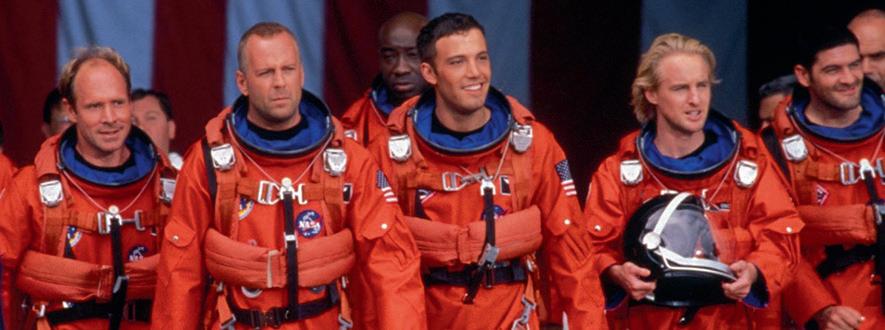


the cycle, it has been subjected to misinterpretation. Although it qualifies as a science fiction/disaster movie, I see it as an epic form of the old Warner Brothers movies about workingclass men who have to step up and rescue a situation through their courage, true grit, and knowledge of machines—productions such as Raoul Walsh’s Manpower (1941) and Alfred E. Green’s Gold (1940). The “science fiction” or “disaster movie” elements of Armageddon fit into the epic form—a form that exists to make movie stories we already know grander, larger, and more “real” in historic setting. (A failed epic settles for the definition put forth in Nicholas Ray’s 1950 film In a Lonely Place: “. . . a picture that’s real long and has lots and lots going on.”) Armageddon is grand, large, and set at NASA, but, the story of Stamper, his daughter, and his hard-living, oil-drilling buddies is the kind of movie that has previously been smaller and tighter. This film makes these ordinary men noble, lifting their efforts up into an epic event. Here, working men are not only saving the overeducated scientists and politicians who can’t do anything (and who probably went to Yale and Harvard), but, incidentally, the entire population of the planet.
By Jeanine Basinger JUNE 21, 1999
Jeanine Basinger is the Corwin-Fuller Professor of Film Studies, the founder and curator of the Wesleyan Cinema Archives, and the founding chair of the Film Studies Department at Wesleyan University. She is the author of eleven books on film, as well as numerous articles and book reviews, and a trustee of both the National Board of Review and the American Film Institute.
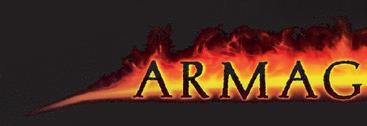

NODDEGAMRA si rednu emoHenotshcuoTmorfesnecilevisulcxe diVoe MT © 1202 b y T o u c h s t o n e H o me V i deo. All Rights Reserved. ©2021TheCriterionCollection. All Rights Reserved. Cat. no. CC1548L. ISBN1-55940-895-2 . :gninraW ecnamrofrepcilbupdezirohtuanu , gnitsacdaorbro, iypoc n g i s a ivloita o n o f a p p l i c a b le laws. Printed in the USA. Firstprinting2021.
Armageddon - Criterion Collection Laserdisc Preservation
www.dvdcompare.net/comparisons/film.php?fid=68
Armageddon: Special Edition #384 (1998) (Uncut) [CC1548L] www.lddb.com/laserdisc/08537/CC1548L/Armageddon:-Special-Edition
Blu Ray - Region A/B/C
DVD - Region All
Audio: English Dolby Digital 5.1 Surround / Audio Commentary Dolby Digital Subtitles: English
Main title: 1080p
Supplementary material: 480p DVD source
Artwork
Criterion Blu Ray Case - Inlay 273mm x 160mm
Standard Blu Ray Case - Inlay 269mm x 148mm
Standard DVD Case - Inlay 272mm x 182mm
Criterion 4 Page Booklet - Exterior Fold down middle 240mm x 160mm
Criterion 4 Page Booklet - Interior Fold down middle 240mm x 160mm
Standard 4 Page Booklet - Exterior Fold down middle 235mm x 145mm
Standard 4 Page Booklet - Interior Fold down middle 235mm x 145mm
Blu Ray Disc Art 115mm x 115mm





























